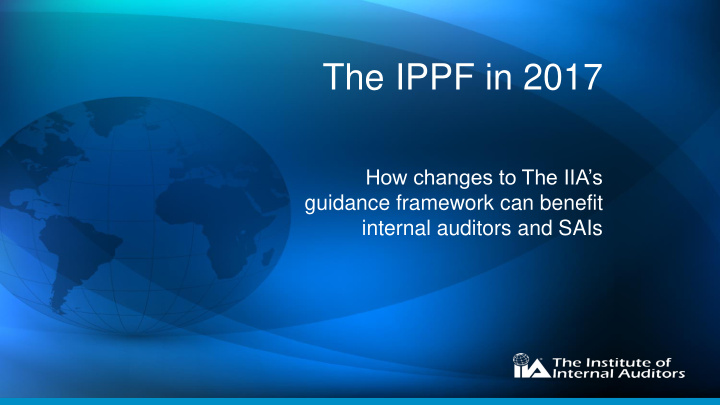



The IPPF in 2017 How changes to The IIA’s guidance framework can benefit internal auditors and SAIs
From the Previous IPPF … To the New IPPF
International Professional Practices Framework • Launched July 2015 – Introduced Mission. – Introduced 10 Core Principles. – Implementation Guidance.
Why Revise the Standards ? • Ongoing process — IPPF mandatory guidance reviewed at least once every three years. – Last revision to the Standards published in 2013. – To keep up with the demands of today’s business environment. – CAEs being asked to accept other roles and responsibilities. • New IPPF introduced in 2015. – Included new mandatory guidance, the Core Principles for the Professional Practice of Internal Auditing. • IIASB reviewed relationship between the Standards and the Core Principles. – Proposed changes better highlight the relationship.
Global Exposure • 16 languages. • 3,000+ webinar attendees. • 8,000+ AuditChannel.tv video views. • 35,000+ unique web page visits.
Global Response • 1,144 survey responses. • 76 institutes represented. Overwhelming support across 42 survey questions related to the revisions to the Standards, with 94.4% agreeing or strongly agreeing.
External Stakeholders • The IPPF Oversight Council provided additional review, which allowed for vital input from other standard-setting bodies and related groups including INTOSAI, NACD, OECD, IFAC and World Bank
Overview of Changes to the Standards New standards to address: • Chief audit executives taking on roles and responsibilities beyond internal auditing. • Potential objectivity-impairing situation of performing assurance role after previous consulting role. Updates to existing standards to clarify requirements: • Relationship between new Core Principles, such as “Is insightful, proactive and future- focused,” and the Standards. • Quality assessment and improvement program. • Communications between CAE, the board, and senior management. • Scope of EQA: must opine on conformance with Standards and Code of Ethics.
Overview of Changes to the Standards Updates to the Introduction to the Standards: • Clarify that the Standards, together with the Code of Ethics, encompass mandatory elements. • Conformance with the Code of Ethics and Standards demonstrates conformance with all mandatory elements. • Modifications to enhance the flow and clarify the introduction Updates to Standards Glossary: • Added definition of Core Principles. • Modified definition of Board. • Modified definition of IPPF. • Modified definition of CAE.
Implementation Guidance Significant work was • Purpose, Authority, and Responsibility • Recognizing Mandatory Guidance in done to update the Internal Audit Charter • Independence and Objectivity dozens of existing • Organizational Independence • Direct Interaction with the Board implementation • Chief Audit Executive Roles Beyond Internal Auditing guides to reflect the • Individual Objectivity IPPF changes ahead • Impairment to Independence or Objectivity of the Jan. 1, 2017 • Proficiency and Due Professional Care • Proficiency effective date. • Due Professional Care
Supplemental Guidance • Practice Guides, Global Technology Audit Guides (GTAGs), and Guides to the Assessment of IT Risks (GAIT) now are part of Supplemental Guidance under the new IPPF.
Next Steps: Future of the IPPF Next Steps: • New Standards go into effect Jan. 1, 2017 • New 2017 IPPF (Redbook) available 1Q 2017. • New QA manual available 2Q 2017. • Certifications: Exam Questions no earlier than July 1, 2017. https://global.theiia.org/standards- guidance/Pages/2016-Standards-Exposure.aspx
Global Public Sector Insight • The IIA’s Global Public Sector Insight (GPSI) compared INTOSAI and IIA authoritative guidance frameworks (1Q 2016) • Comparison found a great deal of similarity between the frameworks: – Principles-based – Strive to strengthen the position of internal audit profession – Recognize IA conducted in diverse legal and cultural environments
IPPF and Government Audits • The IPPF is already the basis for public sector auditing in many countries. • e.g. numerous UK government agencies currently use IIA Standards.
Parting Thoughts • INTOSAI and IIA partnership continues to grow. • Two strong organizations working toward a common goal. • Eager to find new opportunities for collaboration and cooperation.
Recommend
More recommend